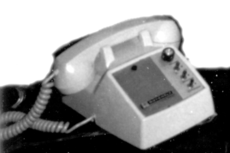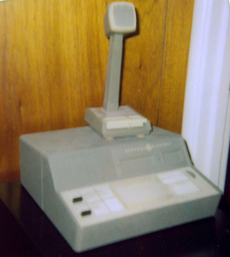
Tone remote
Encyclopedia


Two-way radio
A two-way radio is a radio that can both transmit and receive , unlike a broadcast receiver which only receives content. The term refers to a personal radio transceiver that allows the operator to have a two-way conversation with other similar radios operating on the same radio frequency...
base station
Base station
The term base station can be used in the context of land surveying and wireless communications.- Land surveying :In the context of external land surveying, a base station is a GPS receiver at an accurately-known fixed location which is used to derive correction information for nearby portable GPS...
is located away from the desk or office where communication originates. For example, a dispatch
Dispatch (logistics)
Dispatch is a procedure for assigning employees or vehicles to customers. Industries that dispatch include taxicabs, couriers, emergency services, as well as home and commercial services such as maid services, plumbing, HVAC, pest control and electricians.With vehicle dispatching, clients are...
center for taxicabs may have an office downtown but have a base station on a distant mountain top. A Tone remote, also known as an EIA Tone remote, is a signaling
Signalling (telecommunications)
In telecommunication, signaling has the following meanings:*the use of signals for controlling communications...
system used to operate a two-way radio base station by remote control.
A tone remote may be a stand-alone desktop device in a telephone housing with a speaker where the dial would have been located. It may look like a desk top base station. Or, it may be an integral part of a computer-based console system with touch-screens in a dispatch center.
History
The first two-way radio remote controls utilized a harness of wires extending speaker, microphone, and controls for options such as channel selection or CTCSS switches. This limited a base station to being within tens to hundreds of feet from the user's workstation. Early systems often had volume unit meters, clocks, and switchboard keys.1960s two-way radio remote control consoles used direct current loop
Current loop
A current loop describes two different electrical signalling schemes.- Digital :For digital serial communications, a current loop is a communication interface that uses current instead of voltage for signaling...
s. Users would run ordinary telephone wiring from the remote consoles to the radio base station chassis. In some cases, the base station was located at the same address as the control console. In other cases, the base station was located at a distant site. For distant sites, a dry pair of telephone wires called a private line- or RTO circuit was leased from the telephone company.
As pair gain
Pair gain
In telephony, pair gain is a method of transmitting multiple POTS signals over the twisted pairs traditionally used for a single traditional subscriber line in telephone systems. Pair gain has the effect of creating additional subscriber lines...
electronics and microwave radio came into widespread use throughout the public switched telephone network
Public switched telephone network
The public switched telephone network is the network of the world's public circuit-switched telephone networks. It consists of telephone lines, fiber optic cables, microwave transmission links, cellular networks, communications satellites, and undersea telephone cables, all inter-connected by...
, telephone companies filed tariffs to eliminate their past responsibility of providing leased circuits with direct current continuity. If the base station were located across town in an area served by a different telephone exchange
Telephone exchange
In the field of telecommunications, a telephone exchange or telephone switch is a system of electronic components that connects telephone calls...
, the only available circuits reaching the distant exchange might be a single voice-grade channel in a D-4 channel bank on a DS-1
Digital Signal 1
Digital signal 1 is a T-carrier signaling scheme devised by Bell Labs. DS1 is a widely used standard in telecommunications in North America and Japan to transmit voice and data between devices. E1 is used in place of T1 outside North America, Japan, and South Korea...
or a single microwave radio baseband channel. Tone remotes became necessary with the wide use of telephone carrier or multiplexing
Multiplexing
The multiplexed signal is transmitted over a communication channel, which may be a physical transmission medium. The multiplexing divides the capacity of the low-level communication channel into several higher-level logical channels, one for each message signal or data stream to be transferred...
equipment. They require only a voice-grade audio path with roughly flat equalization from 300-3,000 Hz
Hertz
The hertz is the SI unit of frequency defined as the number of cycles per second of a periodic phenomenon. One of its most common uses is the description of the sine wave, particularly those used in radio and audio applications....
. A circuit that could pass audio in both directions could be used for remote control.
Tone format employed
Tone remotes send commands to a base station using function tones, a series of two tones in sequence. The first tone is 2,175 Hz and is 100-300 milliseconds in length. The most common second tone is 1,950 Hz. The most commonly-used tone sequence in tone remote controls is the channel 1 transmit command. The default for this command consists of a high-level 2,175 Hz followed by a lower-level 1,950 Hz. A continuous, low-level 2,175 Hz tone follows. Voice is multiplexed over the tone. So long as the 2,175 Hz tone is present, the transmitter remains on. A notch filter is supposed to eliminate the 2,175 Hz low-level tone from the transmit audio. General Electric Mobile Radio called the high-level tone, '"Secur-it tone", and called the low-level tone "hold tone." In the industry, the low-level continuous tone is often called, low-level guard tone. The low-level tone is present at the same time as transmitted voice.Receive
Some function tones are sent without the continuous low-level tone. These are commands that change a state of the base station. An example is turning off the receiver CTCSSCTCSS
In telecommunications, Continuous Tone-Coded Squelch System or CTCSS is a circuit that is used to reduce the annoyance of listening to other users on a shared two-way radio communications channel. It is sometimes called tone squelch...
decoder (the monitor function).
Receive commands use a function tone only. They may include things like:
- Turn off CTCSS decode or monitor
- Switch base station to channel 2
- Set squelchSquelchIn telecommunications, squelch is a circuit function that acts to suppress the audio output of a receiver in the absence of a sufficiently strong desired input signal.-Carrier squelch:...
threshold tight/loose - Repeater set-up/knock-down
- Turn on second receiver in dual-receiver base station.
Transmit
Transmit commands use a function tone followed by low-level guard tone, which holds the transmitter on. They may include things like:- Transmit, channel 1
- Transmit, channel 2
- Transmit, channel 3
- Transmit, channel 4
- Transmit with CTCSS encode disabled (used to send two-tone sequential paging tones)
- Transmit site 1
- Transmit site 2
- Transmit site 3
- Transmit site 4

Levels and equalization
Level discipline, setting the tone output levels at the remote control, affects the reliability of a tone remote. Audio levels set too low may cause the transmitter to drop out when speech peaks occur. The combination of voice and signaling tones is supposed to lie in a balance. If everything is set ideally, a notch filter at the base station blocks the steady 2,175 Hz tone from going out on the air.Level discipline varies from one system to another. In order to get the transmitter to key reliably, sometimes the continuous tone that holds the transmitter on may have to be set so it is heard in the transmit audio. Sometimes equalization
Equalization
Equalization, is the process of adjusting the balance between frequency components within an electronic signal. The most well known use of equalization is in sound recording and reproduction but there are many other applications in electronics and telecommunications. The circuit or equipment used...
problems with a telephone circuit make it necessary to run higher levels than a circuit with a flat response from 300 to 3000 Hz would require.
Audio level compression
Remote control consoles use audio level compressionAudio level compression
Dynamic range compression, also called DRC or simply compression reduces the volume of loud sounds or amplifies quiet sounds by narrowing or "compressing" an audio signal's dynamic range...
in transmit and receive audio paths.
In documentation for most any console, receive audio is described as having a 30 decibel (db) knee of compression: for a 30 db variation in input audio level, the speaker volume changes by 3 db. This is desirable because persons calling on the radio who are whispering or yelling would ideally be intelligible and be presented to the console user at roughly the same volume. It helps reduce the need to constantly adjust the volume control to accommodate different voices. It also helps the console user talk on the telephone without loud sounds coming from the remote control speaker. A professional dispatcher
Dispatcher
Dispatchers are communications personnel responsible for receiving and transmitting pure and reliable messages, tracking vehicles and equipment, and recording other important information...
will often set the console volume at a setting similar to the telephone's perceived volume. This allows the dispatcher to shift her attention between the radio and the phone without continually adjusting volume controls during a conversation.
Transmit audio is compressed so that field units can hear the base station user over background environmental noise present in cars and in the street scape around walkie-talkie
Walkie-talkie
A walkie-talkie is a hand-held, portable, two-way radio transceiver. Its development during the Second World War has been variously credited to Donald L. Hings, radio engineer Alfred J. Gross, and engineering teams at Motorola...
users.
Tone conflicts
In designing a system, it is important to pick selective callingSelective calling
In a conventional, analog two-way radio system, a standard radio has noise squelch or carrier squelch which allows a radio to receive all transmissions. Selective calling is used to address a subset of all two-way radios on a single radio frequency channel...
tones that do not conflict with remote control tones in use.
Analog voting
Diversity combining
Diversity combining is the technique applied to combine the multiple received signals of a diversity reception device into a single improved signal.- Various techniques :Various diversity combining techniques can be distinguished:...
systems usually utilize either 2,175 Hz or 1,950 Hz as an indication a receiver is squelched or idle. In the case of 2,175 Hz, the steady tone leaking from a receiver phone line, or from the output of the voting comparator, may cause the transmitter to lock on.
Two wire versus four wire
The simplest tone remote system uses a two-wire audio circuit to operate a simplex base station. If simultaneous transmit and receive is required, a four-wire or full duplex audio path to the base station is required. Systems using diversity combining (voting) require four-wire circuits.Some systems where transmitter steering is employed may also require a separate audio path for transmit and receive, (four-wire circuits).

